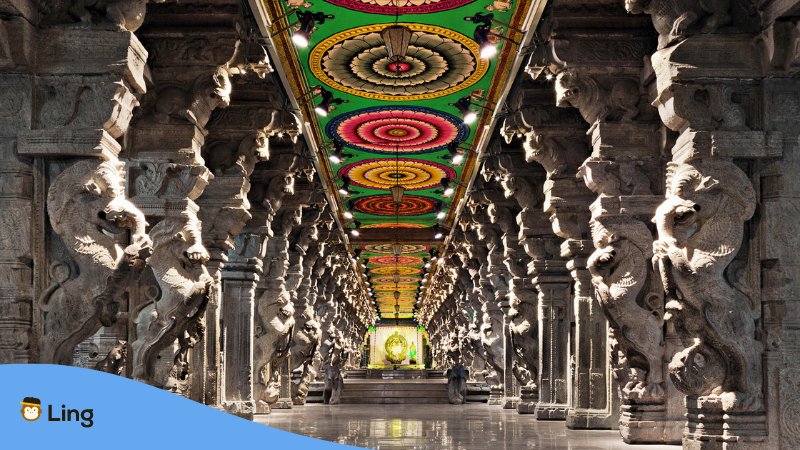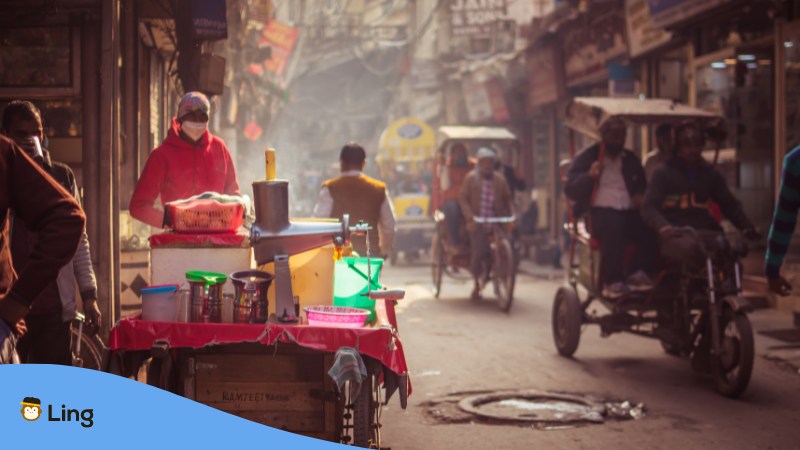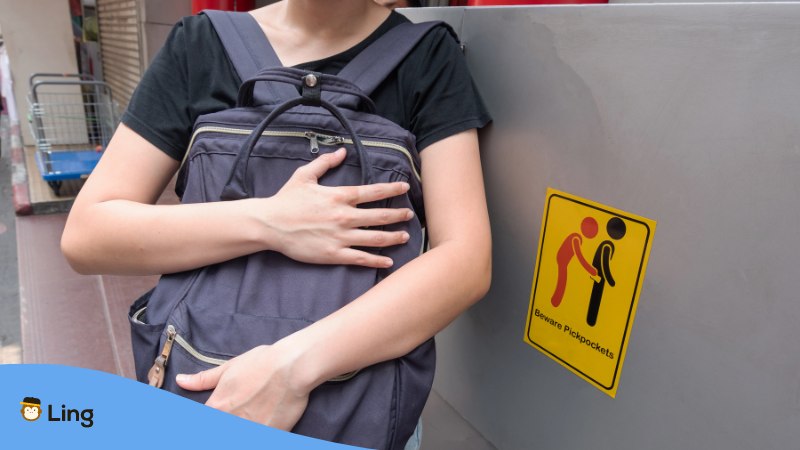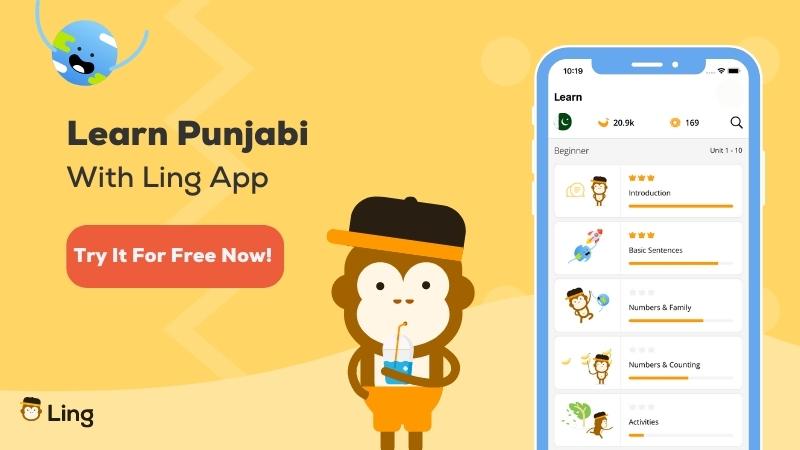Imagine walking down a busy street filled with the aroma of rich spices and the sound of lively music. People of all ages, dressed in colorful traditional attire, welcome you with a warm smile and a friendly greeting.
This is the vibrant world of Punjab, a region located in northern India. But to truly experience the magic of this cultural haven, you must first understand and respect the do’s and don’ts in Punjabi regions.
To help you with that, we’ll guide you through local customs and practices about behavior, food, drink, money matters, and safety. Besides learning the language, with this, you can make the most of your travels to the enchanting world of Punjabis.
Do’s And Don’ts Of Behavior In Punjab
1. Dressing Conservatively
Punjabi culture is conservative when it comes to dressing, especially for women. It’s best for female tourists not to wear shorts or revealing clothing. Instead, dress modestly and choose clothes covering your shoulders and knees.
Women can wear traditional Punjabi suits, which consist of a long tunic, loose pants, and a scarf. Men can wear traditional Punjabi kurta-pajamas, which are comfortable and easy to wear in the region’s warm climate.
2. Effective Communication
While English is widely spoken in Punjab, learning Punjabi (the native language) can help you connect with the locals more deeply.
Common phrases include “Ki haal aa?” (How are you?) and “Shukriya” (Thank you). If you are interacting with Sikhs, call them by their Sikh names, which are typically one or two words.
For example, if someone’s name is Gurpreet, their Sikh name might be Gurdeep, which means “lamp of the Guru.”
However, not all Sikhs may use their Sikh name on a regular basis, especially if they live in a predominantly non-Sikh area or have adopted a more Westernized lifestyle.
3. Proper Greetings And Gestures
Punjabis are known for their warm and friendly nature, and a simple “Namaste” (Hello/Goodbye) can help you show respect for their culture.
When greeting someone, placing your hands together in a praying gesture and bowing your head is common.
Remember that men should avoid shaking hands with women unless they initiate it. Like in most Asian countries, physical contact is generally avoided between the sexes for Punjabis.

4. Avoiding Public Displays Of Affection
In Punjab, public displays of affection, like holding hands or kissing, are considered inappropriate.
So, as tourists, respect the local customs and cultural norms by refraining from such behavior in public places.
Instead, show affection through verbal expressions or small gestures, like offering a kind smile or holding hands discreetly.
5. Being Mindful Of Personal Space
Respecting personal space is crucial when interacting with locals in Punjab. Avoid unnecessarily standing too close to others or touching them, as this can be seen as intrusive.
Always ask for permission before taking photographs of individuals, and respect their wishes if they decline. This shows respect for their privacy and helps build positive relationships.
6. Respecting The Local Culture And Customs
Obviously, Punjabis are proud of their culture and history. So, avoid derogatory comments or jokes about their religion, culture, or customs. Those behaviors can offend the locals and make your stay uncomfortable.
Instead, show interest and appreciation for their way of life by asking questions and learning more about their customs. This will help you build deeper connections with them and make your stay more enjoyable.

Do’s And Don’ts Of Visiting Hindu Temples In Punjab
7. Removing Footwear Before Entering
Whenever you visit temples in Punjabi regions, one of the most essential customs is removing your footwear before entering the temple premises.
This is a way to keep the temple clean and show respect for the sacred space. Visitors should ensure their footwear is secure or keep it in a designated area to prevent theft.
In Punjabi culture, saying “Aapne jutte nikalo” commonly means “remove your shoes” when entering a temple.
8. Covering Your Head
Another important Punjabi etiquette to follow is to cover your head. This signifies respect and humility towards the gods and goddesses worshiped inside.
Scarves or shawls are usually provided at the entrance of most temples, like the Golden temple. But bringing your own is recommended as a sign of respect.
For Punjabi people, it’s customary to say “Aapna sir dhang naal dhakko” which translates to “cover your head” when entering a temple.
Visitors should also dress conservatively, covering their shoulders and knees as a sign of respect.
9. Respecting The Sanctity Of The Temple
Be mindful of your actions and show respect for the temple’s sanctity. For Punjabis, it’s customary to say “Teerath de andar, saj dhaj ke jana,” which means “enter the holy place with respect and humility.”
Visitors should also avoid touching or leaning on the idols, which is disrespectful. Instead, stand at a distance and observe the rituals and traditions being performed.
Finally, avoid making noise or taking photographs inside the temple. This can disrupt the peaceful atmosphere.
In Punjabi culture, it’s common to say “Shanti rakho” which means “keep the peace,” when entering a temple.

Do’s And Don’ts Of Food And Drink In Punjab
10. Being Cautious With Street Food
If you are feeling adventurous and decide to try street food, exercise caution, as the hygiene standards may not always be up to par.
Ensure the food is cooked thoroughly and served hot to avoid falling ill. Typical street food options in Punjab include “butter chicken” and “samosa,” which are best enjoyed hot and fresh.
11. Drinking Alcohol In Moderation
While the vast majority of Punjab is known for its alcohol consumption, visitors should remember that it is a conservative region.
Drinking in moderation and showing respect for local customs is essential. Public intoxication is one of the don’ts in Punjabi regions; it’s considered inappropriate and can lead to legal trouble.
If you want to indulge, “Lassi” is a refreshing Punjabi drink made from yogurt, water, and spices that will quench your thirst and energize you.
12. Assuming Everyone Drinks Alcohol
Remember that not everyone drinks alcohol in Punjab. It’s not okay to drink in public places, and visitors should be respectful of those who choose not to drink.
If you’re unsure, it’s best to ask before offering a drink. Instead, try some “Nimbu paani” (lemonade) as a non-alcoholic option.
13. Avoiding Tap Water
In Punjab’s hot climate, staying hydrated is essential, but visitors should avoid drinking tap water. Only bottled or filtered water is safe to drink.
Always carry a reusable water bottle and refill it with safe water sources. To avoid confusion, remember that “Paani” means water in Punjabi.

Do’s And Don’ts Of Money Matters In Punjab
14. Paying For Goods And Services
In Punjab regions, it’s always best to carry cash, as cash is king. Though some establishments may accept credit cards, visitors should have small denominations of money to avoid issues with making change.
Keeping some notes of 10, 20, and 50 rupees is recommended, especially when shopping in the local markets.
15. Tipping
While tipping is not always expected in Punjab, it is appreciated as a friendly gesture for good service. Visitors can leave a small tip of around 10% at restaurants, hotels, or for taxi drivers.
In Punjabi culture, it is also customary to offer ‘Baksheesh’ (small gratuity or tip) to holy men or gurus as a form of respect or gratitude.
16. Bargaining
Bargaining is common in Punjab, especially when shopping in markets or bazaars. Visitors should be prepared to haggle and negotiate prices.
However, do so in a friendly and respectful manner. The Punjabi people call bargaining ‘Maukka chukka,’ which is seen as an art form.

Do’s And Don’ts Of Safety In Punjab
17. Being Aware Of Your Surroundings
It’s important to be “Jagrook” (alert) to your surroundings, especially in busy urban areas. Avoid walking alone at night and opt for “Taiksee” (taxis) or other reputable modes of transportation.
18. Being Cautious With Money And Valuables
Punjab is a smart tourist destination, and visitors should be cautious with their money and “Vasiyat” (belongings).
Pickpocketing and scams can happen in crowded places, so keep your belongings close and avoid carrying large amounts of cash.
Always use ATMs in well-lit areas and exchange currency at “Aadarsh” (reputable) establishments.
19. Being Respectful Of Local Customs And Laws
Visitors should show “Adab” (respect) towards local customs and laws, especially those related to alcohol and public displays of affection.
Violating “Lokal kaanoon” (local laws) can result in fines or “Giraftaar” (arrest). It’s crucial to “Sabhyaachar” (behave appropriately) and avoid “Badtamizi” (rudeness).
Useful Phrases When Traveling Punjabi Regions
If you’re traveling to Punjabi regions, knowing some basic phrases in Punjabi is always helpful. Here are ten phrases that will come in handy during your trip.
| English | Punjabi | Pronunciation |
| Hello/Greetings | ਸਤ ਸ੍ਰੀ ਅਕਾਲ (Sat sri akal) | sut-sree-a-kaal |
| How are you? | ਕੀ ਹਾਲ ਹੈ? (Kee haal hai?) | kee-haal-hai? |
| Thank you | ਸ਼ੁਕਰੀਆ (Shukriya) | shu-kree-yaa |
| What’s up? | ਕਿਵੇਂ ਹੈ? (Kivein hai?) | kee-vein hai? |
| I don’t understand Punjabi | ਮੈਨੂੰ ਪੰਜਾਬੀ ਨਹੀਂ ਆਉਂਦਾ (Mainu Punjabi nahi aunda) | main-oo pun-jah-bee na-hee aun-daa |
| Where do you want to go? | ਕਿੱਥੇ ਜਾਣਾ ਹੈ? (Kitthe jaana hai?) | kit-thay jaa-naa hai? |
| I need _____ | ਮੈਨੂੰ _____ ਚਾਹੀਦਾ ਹੈ (Mainu _____ chahida hai) | main-oo _____ chaa-hee-daa hai |
| Can I get a little discount? | ਥੋੜਾ ਸਾ ਡਿਸਕਾਊਂਟ ਮਿਲੇਗਾ? (Thoda sa discount milega?) | tho-daa-saa dis-kaoont mil-ay-gaa? |
| Where is the ATM? | ਏਟੀਐਮ ਕਿੱਥੇ ਹੈ? (ATM kitthe hai?) | a-tee-aim kit-thay hai?) |
| Give me tea/buttermilk | ਚਾਈ / ਲੱਸੀ ਦਿਓ (Chai/Lassi de do) | chai/lus-see day do |
Knowing some basic Punjabi phrases can help you make your trip more enjoyable and memorable. Don’t be afraid to use them and immerse yourself in the local culture. Safe travels!

Learn The Do’s And Don’ts In Punjabi Regions With Ling
Punjab is a beautiful and culturally rich region that offers a unique experience to travelers. By following the do’s and don’ts in Punjabi regions, you can ensure a safe and enjoyable trip.
Remember to respect the local customs and practices, be cautious with valuables, and always be aware of your surroundings. With these in mind, you can fully immerse yourself in Punjab’s vibrant and welcoming world.
At Ling, we firmly believe that learning a new language can enhance your travel experience and open up opportunities. With the Ling app’s fun and engaging language lessons, you can start learning Punjabi or any other language for free.
Join us now by downloading the app from App Store or Google Play!
























